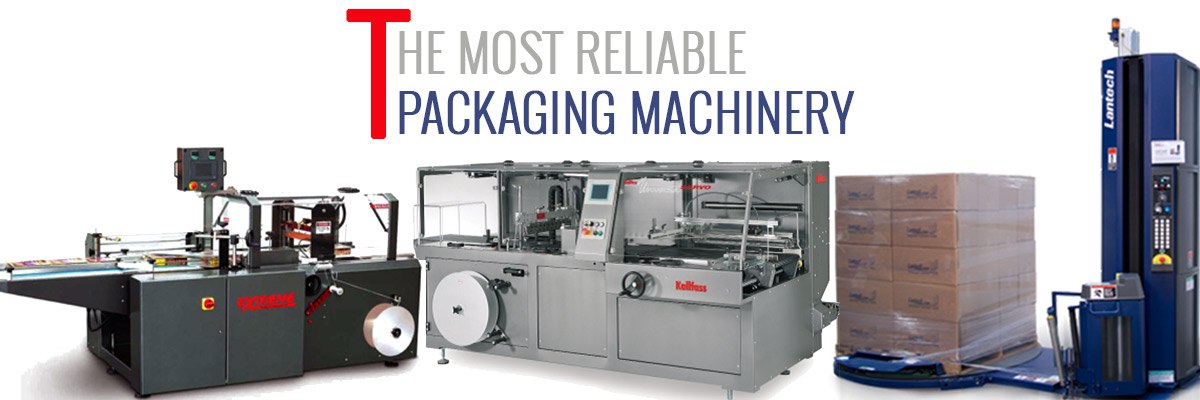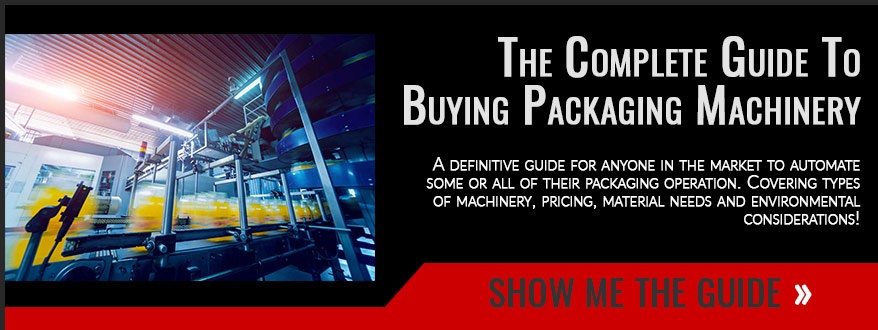Exploring The Different Types Of Packaging Equipment
So, you have decided that you want to do your packaging in-house. And you are hoping to purchase the right packaging equipment to build a quality packaging line.
You are looking for a clear, concise, and simple guide to purchasing packaging equipment. You want to know the different kinds of packaging machinery and any pertinent information regarding said hardware.
You would appreciate access to additional information about the types of packaging machinery that are of interest to you.
Ideally, you would like to find a one-stop-shop that can help guide you from a minimal understanding of packaging equipment and its related elements to a more educated stance on the subject.
This article will provide you with an exploration of the different kinds of packaging machinery currently available.
With the information in this article, you will be able to begin formulating ideas about which types of packaging machinery are best suited for your business and packaging line.

What Are The Different Types of Packaging Equipment?
There are many types of packaging machinery currently available. The sum total of devices discussed in this article is but a portion of the equipment on the market today. There are some other types of packaging machinery not mentioned here.
If you are interested in a specific piece of machinery that does not feature in this post, please reach out to one of our packaging specialists for guidance in sourcing information about said machinery.
As for the different types of packaging machinery that is currently available on the market, these include but are not limited to:
Machinery On Our Website
- Heat Sealers
- Shrink Tunnels
- Bagging Machinery
- Conveyors
- Strapping Machines
Additional Equipment We Sell That Is Not Featured On Our Website
- Labelers
- Friction Feeders
- Bundlers
- Flow Wrappers
- Vertical FFS Machines
- Pouch Openers
- Band Sealers
- Case Erectors
- Case Loaders
- Tapers
- Specialty In-Feeds
- Stretch Wrappers
Suppose the machinery you are interested in is part of the second list above. In that case, you will want to speak one-on-one with a packaging equipment expert to garner information about these devices.
If the type of machinery that you are looking for is not on either of the lists above, we are not the right packaging machinery vendor for you, and we recommended looking elsewhere for your needs.
Exploring The Packaging Equipment That Is Featured On Our Website
While there are many different varieties of packaging equipment, we do not sell all types of said machinery here at Industrial Packaging. As such, we will be covering only the kinds of packaging machinery that we do sell.
The list below reflects the types of packaging machinery that we currently have available on our website and will be the types of machinery that this article focuses upon.
- Heat Sealers
- Shrink Tunnels
- Bagging Machinery
- Conveyors
- Strapping Machines
1. Heat Sealers
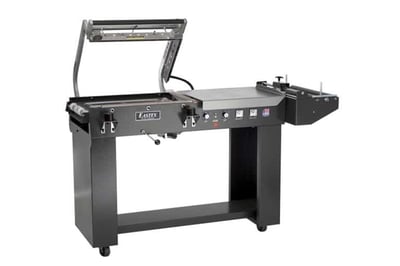
Heat sealers are used to seal products inside of a bag, sleeve, or another shaped container of shrink film. A heating element on the machine heats the shrink film, causing a seal to form between the film layers touching the heating element.
After the product has been sealed inside of some shape of shrink film, the product moves down a conveyor to a heat tunnel.
Heat sealers come in many different shapes, sizes, and price points. These devices come in manual, semi-automatic, and fully automatic variations.
There are several different forms of heat sealers, including L-bar sealers, intermittent motion side sealers, and continuous motion side sealers (which include side and lap seals).
Heat sealers are used for packaging products such as board games, frozen food, tea, DVDs, CDs, electronics, and many other consumer goods and products.
If you are interested in learning more about heat sealers, we would recommend a deeper exploration of these devices.
Need help buying packaging machinery?
2. Shrink Tunnels
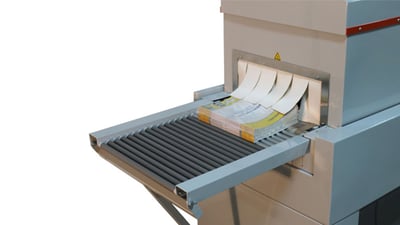
Shrink tunnels (also called heat tunnels), are another staple of a shrink film packaging line. These devices are essentially industrial ovens that are used to heat the shrink film containers that have been sealed by one of the sealers mentioned above.
Conveyors that move products from sealer to tunnel are an integral part of the sealer and are not typically a separate piece of machinery.
As the product moves via conveyor belt from the sealer to the heat tunnel, the heating element inside of the tunnel heats up. The tunnel circulates hot air which activates the film to shrink around the product.
There are single and double chamber tunnels which are specified based on the speed and size of the product.
After leaving the heat tunnel, the product will move on to the following stations of your packaging line for whatever (if any) subsequent or secondary packaging and then onto preparation for shipping.
Heat tunnels are being used for many of the same applications mentioned above in the heat sealer section.
For a deeper dive into the various types of shrink tunnels and their respective applications and related information, we would suggest perusing an in-depth guide to shrink tunnels.
3. Bagging Machinery
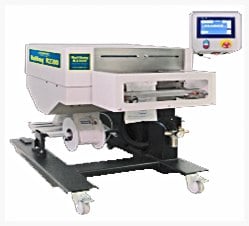
Baggers or bagging machines are a type of packaging equipment used to package items in roll bags or poly bags.
Most baggers (including what is commonly referred to as manual baggers) are either semi-automatic or automatic machinery. There is also another type of bagger called a drop bagger. Drop baggers feature a fan that blows air, opening the bag prior to filling. The bags for drop baggers are supplied on a wicket.
Basically, the machine features a roll of one of the bags mentioned above that auto-feeds the bags through the device. An operator will assist the machinery in inserting your product into a bag or with fully-automatic machinery; this function will be done exclusively by the equipment itself.
If you would like more information regarding this type of packaging machinery, we would suggest some additional reading.
4. Conveyors
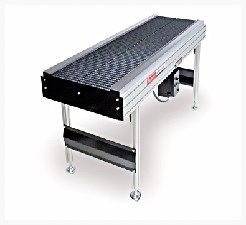
Conveyors are devices that are used to move your products from one part of your packaging line to the next.
Conveyors feature several different modules to move your product. These include belts or rollers, which are usually made from plastics, rubber, or metals.
When a product comes to a conveyor, it moves from one end of the conveyor to the next via the belt or the rollers.
Some conveyors are powered by an electric motor with an AC or DC drive which can be variable speed.
Some conveyors are not powered. On non-powered devices, the products are pushed by line workers from one end of the conveyor to the next. Non powered conveyors also include gravity roller conveyors which use a height adjustment and gravity to move the products.
For more information about conveyors, it is well advised to read articles about conveyor systems to gain more knowledge of these devices.
5. Strapping Machines
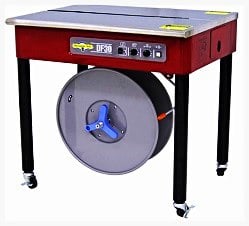
Strapping machines, which are commonly referred to as strappers, are devices that apply strips of strapping materials to an object.
Strapping is used to secure boxes, palletize products and ensure proper load containment.
There are handheld strappers that are more commonly known as tensioners which can be used to apply strapping manually.
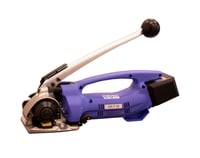
There are also larger strapping machines that are available in manual, semi-automatic and fully automatic variations.
Strapping machines are popular devices for applications, including load containment and palletization. Strappers are commonly used to apply strapping to products such as school lunch trays and plastic modeled items. Strappers are also utilized for bindery applications.
When a full-sized strapper (not a tensioner) is used for packaging your products, the strap is fed through an arch from the coil attached to the machine. When activated, it tensions and seals the strap securing your product.
Next, either a human being will work in tandem with the machine to wrap and tighten the strapping material around the product, pallet, or other item being strapped.
With fully automatic strapping machinery, this entire process is done by the machine itself.
If you want to gain more knowledge about this type of machinery and its applications, we would suggest continuing your education on the topic.
Which Type Of Packaging Machinery Is Right For Your Business?
After reading this article, you should have a better idea of what types of packaging machinery are currently available and which applications they are good for.
But, you are probably wondering, which type of packaging machinery is right for my needs? Or, if you already know which type of machinery you need for your packaging project, where should you purchase your machinery from?
If you have questions like those mentioned above, we would recommend speaking one-on-one with a packaging expert.
They will be able to help you answer any questions you have about packaging machinery and will assist you in securing a vendor even if we are not ultimately the packaging company you choose for your business.
If, on the other hand, you are not ready to speak with a packaging specialist yet, then you may want to read the free guide to buying packaging machinery below.
This will give you everything you need to think about when preparing to purchase packaging machinery. After reading this guide, you should have everything you need in order to buy the appropriate packaging machinery for your needs.
About Nathan Dube
As the Digital Marketing Specialist at Industrial Packaging, I am honored to create content for such a phenomenal company and work with one of the greatest teams in the Packaging Industry. Whether creating a video, writing blog posts or generating other pieces of content and multimedia, I am always excited to help educate and inspire our prospects and clients to reach their highest potential in regards to their packaging processes and needs.



